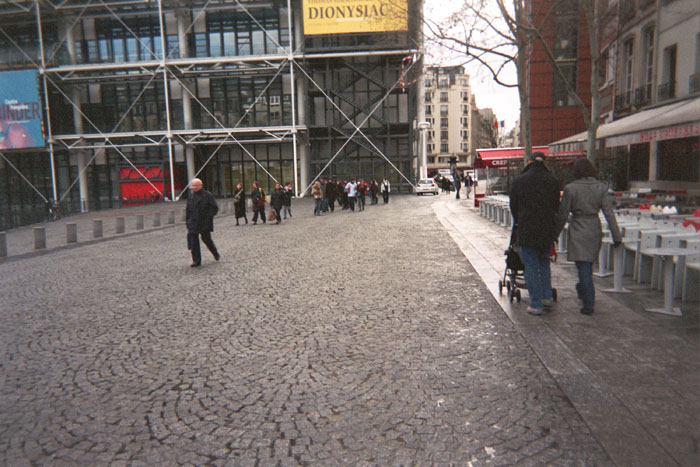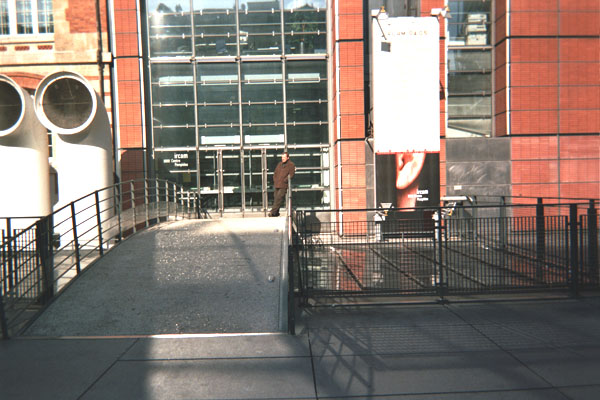Travelogue: France
March 8-April 5, 2005
Roy Lisker
Tuesday, March 8, Boston, Logan Airport : Because of anxiety over the long delays at major airports these days I showed up at 2 PM, 3 hours before departure time. Logan is, after all, the airport used by the hijackers on September 11th, 2001. However the inspection went off without difficulty. The man directing the line was an Israeli who appeared to have lots of experience; he may even have gotten his training in Israel.
Back in the 20th century I used to enjoy watching people arriving and departing from Logan. The restaurants and coffee shops on the upper levels were open to the public and one could sit at a table and try to identify the nationalities of persons getting coming off the planes and into the corridors. This is no longer possible. My options were limited to eating, sleeping, reading or gorging myself on existential despair, the usual ones. Sometimes one is fortunate in striking up an interesting conversation. This didn't happen on this occasion.
Marginally less uneventful was the transatlantic flight itself , for which of course one must be thankful: "God" was invented for those moments when one feels one ought to be thankful to someone without knowing whom. The sky bright and dry in Boston was darkened with massed clouds when the plane alighted at Aeroport Charles de Gaulle around 6 the next morning. A light drizzle persisted throughout the day, only abating at night when it was too late to enjoy the good weather.
Logan Airport is well-maintained. Its bathrooms, in particular are not in such a state as to incite complaints in persons not afflicted with a dirt phobia. Not so at Charles de Gaulle. The airport is shabby and old ( Not the same thing! I turn 67 in September). The bathrooms are singularly disgraceful, with dirty water pouring out of the urinals and refuse lying about everywhere . Eh bien! I hadn't come all the way to France to compare bathrooms! I can report however that the days of the hole in the floor and whisk broom against the wall are (in most settings) largely things of the past. This outmoded technology is richly satirized in my novel circa 1989: "The Eiffel Tower Gang", to which I will be refering as needed.
From previous sojourns France I knew that, unlike England, America and other island nations (or insular mentality) passing through customs would not be unduly complicated. A sign above our heads to the right stated that persons with nothing to declare could follow a designated path. This made it quite easy to pass through with the 2 million dollars in illegal currencies stuffed in the false bottoms of my suitcases.
I'd done the route several times before, and knew that one locates and climbs aboard an elevator that descends to a lower level where there are buses to the RER station. The RER (Reseau Express Regional), is a miracle of modern engineering. Here is what I say about it in "Eiffel Tower Gang":
" Herein the French have accomplished a miracle of modern engineering, par for the course from the nation that razed the Bastille, raised the Eiffel Tower, rectified the Transit of Venus, reaffirmed existence through doubt, and restored the Pantheon. In the last decade a new subway system has been immersed totally within the musculature of the old. Called the Reseau Express Regional ( RER ) , it brings the suburbs into the downtown in a matter of minutes. What hope, indeed, can there be for a civilization that enables its Third World street cleaners to leap, in only a few stops, from the boiling hovels of Belleville to the crusty villas of the snobs of Neuilly? "
At the RER station I discovered that tickets for the RER B into Paris are dispensed from a machine that only accepts coins, of which I had none . A college student standing by the machine volunteered to use his debit card to buy my ticket. He spoke English with a Boston accent , while his French was a familiar variety of "Parigo" street slang. I didn't learn much about him other than that he's a student at Harvard and was visiting relatives in Paris.
Unfortunately the debit card had been issued by the Fleet Bank, and Fleet had been taken over by the so-called Bank of America (bank of so-called America, or even so-called Bank of so-called America. ) several months before. I know this because Fleet was my bank ( and has become the so-called Bank of America, etc.), and because I'd consulted my branch before coming to learn the best way to withdraw currency in France using my ATM card.
Drifting about on my own I came upon a dimly lit room in which young women standing behind a counter were selling tickets to the RER. The teen-ager who sold me the ticket (7 Euros, around $10), appeared somewhat disdainful of my French ( which isn't bad for an American's). However since her English was non-existent we got along famously.
The RER B migrated through desolate, wind-swept countryside to the Gare du Nord, then from there to station Chatelet-Les Halles, my destination. The trip normally takes about 40 minutes. About one-third of the way down it stops at the suburban village of Aulnay-sous-Bois. I know this town from living there in a commune with art students from the Beaux-Arts for several months in 1971. My one published novel "Getting That Meal Ticket" was written there. When I pointed this out to the student who'd befriended me, he said, "That's really interesting. I wasn't even born then." To me it felt like yesterday!
When the train pulled into and stopped at the Aulnay station a black African guest worker climbed on board. He was about 30, and strongly built. He pulled the edges of his blue winter coat against the chilly rain. I'd placed my luggage, two heavy suitcases and a shoulder bag, on the remaining 3 seats of the stall I was occupying. Despite this he insisted on squeezing in behind my luggage, jamming his legs in the small space between it and the seat! There were other seats available to him which made his procedure seem rather strange.
In addition to the two of us the box-car held other Third World immigrant workers and several passengers who'd come off the Air France flight. Once a charming village in the 19th century French style Aulnay has become a "bidonville" (shantytown) filled with populations of immigrant workers from former French colonies: the transformation had already begun when I was there 30 years ago. Much of this population lives in discarded boxcars standing on railway sidings. Going into Paris in the mornings, I could see the families getting up from their mattresses on the flatbed boxcars
Three stops down the road my novel companion suddenly jumped up from his seat and ran off the train. Now I realized what he'd been up to: "station hopping", a common practice in the French system of public transportation. It's universally practiced, which explains why, if you're caught, the fines are gigantic. In France the majority of citizens, including those in the government itself, hate the government, and consider it a major triumph if they can wrest 50 centimes from the system. In addition to which the man was probably broke. Guest workers are treated badly here.
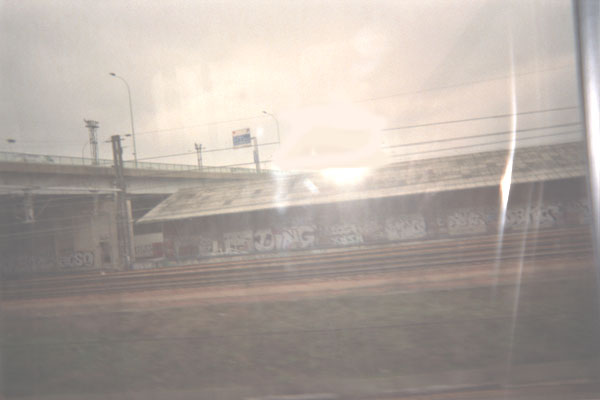
The embankments between Aulnay-sous-Bois and the Gare du Nord are all thickly impacted with graffitti, much of it good work based on American Nuyorican models: mile upon mile of fancy initializing, portraits, crowd scenes and psychedelic designs. Between Drancy ( the German prison camp in WWII), and the Gare du Nord one observes nothing but a truly wretched , in fact horrible moonscape of industrial devastation. These pictures were taken on the return trip.
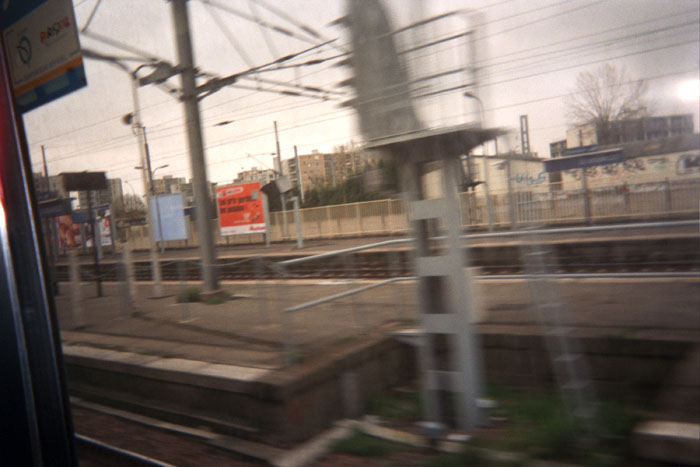
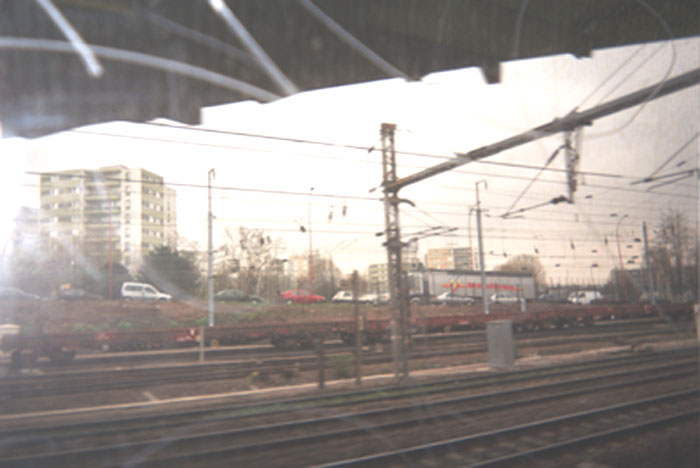
I descended from the train at the Les Halles metro station, site of the famous (and long demolished) open markets, now home to a many-tiered shopping mall incongruously named the Forum.
It is a 3-millennium old fiction in the enlightened West that shopping malls are the cradle of democracy.
The Forum connects to the Chatelet station a kilometer or so to the southeast, by a spider web of interlacing corridors. In "Eiffel Tower Gang" it is compared to the foam on the lips of a hydrophobic bat. The connection I needed for the Place de la Republique, was on of the Mairie des Lilas line at Chatelet
The lengthy, confusing trajectory that one must take to get from Les Halles to Chatelet is described, at great length, in "Eiffel Tower Gang" . Making the connection one navigates not one, but two 'moving sidewalks' (trottoirs roulants ). These churn slowly through tomb-like vaults under low ceilings. The time was 8 AM, the rush hour; all the burrows of this multiply-connected cavern were filled with people scurrying about like lunatics. It is understandable that many of them were worried about showing up late for work; yet there was a quality of dementia above and beyond this in this exhibition of panic and chaos.
Years of experience have taught me that one does not , in Paris, behave like a Parisian. A Parisian is a bull that's been hypnotized by the red cape: he knows a lot about being a bull but has no idea of where he's going. I therefore plunked my two too heavy suitcases, ( and too too sullied flesh) down on the rubber treads of the moving sidewalk, leaned against the conveyor belt and allowed the clash of reference frames (walls and rolling sidewalks ) to carry me to my destination.
Not so the others. They slammed past me like entangled clutches of Euripedean Bacchantes, tripping over the suitcases, yelling and swearing, not even taking the time to turn around and curse me to my face. I was home.
Reaching the end of the moving sidewalk I stepped into the corridors of the Chatelet station to discover that I was lost. Fortunately a young woman, an Antillean, came by and offered help. She walked with me through the station, carrying one of my suitcases, down to the entrance of the Mairie des Lilas connection, Then she walked with me onto the quais and stayed with me to make sure that I boarded the right train. The same kind of help was extended to me at the station Republique by a high school student (lycééan) . These two Good Israelis stand in strong contrast to the mobs of pedestrians who banged into me, cursed and ran off.
The Hotel Picard sits in a small, rarely visited street mired in the urban maze off the Avenue du Temple. The help I'd received hadn't done much to relieve the fatigue of dragging my two heavy suitcases around the airport, through the metro station and around this neighborhood. Being unable to sleep on the plane hadn't helped matters, besides which it continued to rain, persistently if not heavily. My one ambition was to reach the Hotel Picard, sign the register for my reserved room and collapse into the sack. It was not to be.
The Picard is a 2-star hotel. Rents begin at 33 Euros ($45) per night. Relative to the standards of hotels of that class it is well maintained. Everything must be paid for, including showers. The bulbs in the light fixtures are at the lowest wattage. Two out of the four in the room were burnt-out; one of them was replaced when I complained. The room was cramped, the corridors narrow, the steep climbs unsettling if not altogether unsafe. I place no blame on Parisian hotel managers however , for the 4- century- old buildings in which they have to reconstruct the interiors of their establishments. At that price the Picard is one of the best deals in town . However two weeks was the outer limit of the time I could afford to spend there, if I wanted the $2000 put aside for the trip to survive the "Bush tax".
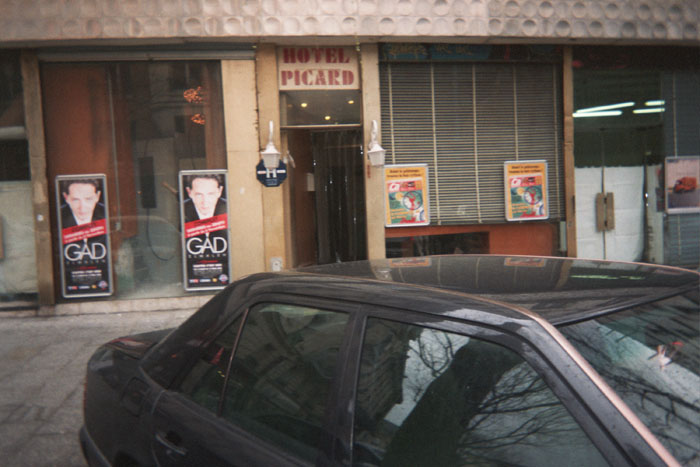
The entire first floor of the Picard was being reconstructed.Someone had had the idea of placing store manikins near the entrance.
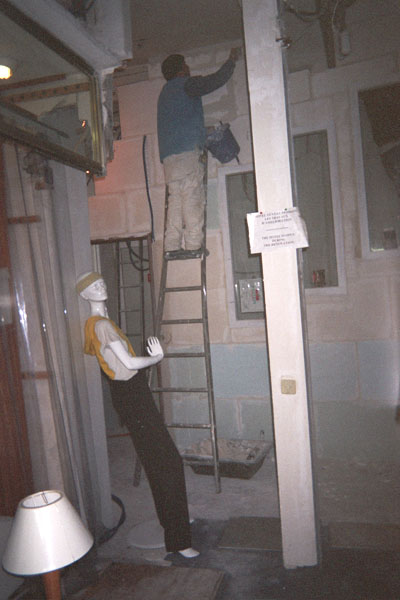
Cheeky at first, the young North African receptionist turned out to be quite charming and accommodating. I may have initially frightened her: the hotel is accustomed to more conventional Americans, and she didn't know where to place me. She let me know right away that I wouldn't be able to occupy my room until 1 PM. I was allowed to leave my luggage in the reception area before returning back into the drizzle, thoroughly exhausted, to endure 4 more hours of roaming the streets.
The streets adjoining the Place de la Republique were filling up with police buses surrounded by cops in full regalia. It didn't surprise me to learn that I'd arrived in Paris in the middle of a week of demonstrations of organizations of workers, lycée students and immigrants: most weeks are more or less like that. After a sleepless night the ubiquitous police presence was just one more source of distress.
My first stop was back at the metro station to purchase a Carte Orange. The Carte Orange is a reddish-orange
Psychologists claim that when the French say "orange" they mean "red". How does this square with the existence of a French town with the name of Orange, from which we get oranges?
photo ID card costing 15 Euros that, used in conjunction with a magnetized ticket issued on Mondays, gives its bearer unlimited travel in the subways for the rest of the week.
A college-aged Algerian sat behind the plate glass window of the ticket compartment . I knew from previous visits to Paris that one has to bring along a photo to attach to this card, and I'd prepared some in advance. As they were taken in the US, the photo wasn't regulation size. The ticket clerk produced a scissors and proceeded to clip away at its edges. Just then his supervisor, a middle-aged woman, entered the compartment. Sensing or perhaps anticipating that he could be having trouble she took the scissors out of his hands and finished the job. Her attitude was written all over her face: "Damn these foreigners! They don't even use regulation size photographs!" Very French of a certain mentality.
The code on my orange card wouldn't be activated until 11, so the young man opened the turnstile and waved me through on my way to the fashionable district around Opera. Here is another tip from a seasoned pro: its in this neighborhood that one finds (apart from the black market, which I would not use owing to my fondness for France) the best currency exchange rates for Paris. The dollar continues to plummet and the best rate I could find was $1.37 to the Euro! In New York just a few weeks before I could have exchanged all my money at $1.33 to the Euro. $460 bought me 338 Euros. No doubt the amount of money lost by not making the exchange earlier has helped to finance the Iraq War.
On the way back through the Marais to the Hotel Picard I paid a brief visit to the Musée des Arts et Métiers. "Arts et Metiers" does not mean "arts and crafts"; the nearest translation is something like "technology and invention." The museum is an extension of the school of engineering, Conservatoire des Arts et Métiers, and exhibits inventions, mostly French, created since the beginning of the Industrial Revolution in the 17th century.
My main reason for going there was to inquire about the "Journée des Femmes en Physique" advertised on the Internet. The puns ("The day of feminine physique?!" ) work in both French and English. I was unable to resist sharing the smirk that came to the lips of the security guard. However, far from being a bawdy fashion show, the exposition is an intended tribute to the woman physicists of France! The counter clerk informed me that it should be ready by Thursday.
I returned to the Hotel Picard at around 12:30 and found that my room was ready. Within minutes I was fast asleep in my bed . However by 4 o'clock I was up and ready to return to the city.My goal this time was on the other side of the Seine, Shakespeare and Company , virtually under the shadow of Notre-Dame cathedral.George Whitman,its owner wasn't in and I was told to come back the next day.
Around 6 I walked over to the Place Maubert a few blocks away from the bookstore and put together a tasty dinner made up of items assembled in a fromagerie , boulangerie and charcuterie . After that I went back to the hotel.
The night clerk, a sculptor,invited me to take a cup of coffee at a dinner table stationed to the left of the reception counter. Seated at the table with us was a young woman, an American from Virginia. She's married to a Polish painter and has been living in Paris for 15 years. Her French was rapid-fire, with a good vocabulary, no grammar at all and very bad pronunciation. Unfortunately one can easily fall into speaking that way. I've therefore resolved to devote thirty minutes to an hour of every day coaching myself (with the help of Le Monde) in speaking French.
Day 2, Wednesday March 9 :
One doesn't need more than a few nights in any French hotel to learn that the petit déjeuner that it offers is a total rip-off. The going price nowadays is 4 Euros 50 , about $6 . The same breakfast at half the price can be digested in a leisurely fashion at a dozen cafés in the neighborhood. If one's pastries are bought in a boulangerie and eaten beforehand, the price plummets still further. Hotel breakfasts are designed only to catch tourists who don't know any better.
It was while I was drinking a café crème in a tabac across the street from the hotel that I learned about the public transportation strike scheduled for the next day, Some of museums, libraries and government offices would also be closed. The tourist population in general was going to be disappointed, however I took it in stride. One doesn't really know Paris without the experience of living through at least one strike in its essential services. Anyway, there was nothing to worry about today. Leaving the café at 8:30 AM I hopped on the metro taking me across the Seine to the Place de l"Odeon. This sits at the bottom of a hill crowned by the internationally famous Odeon Theater and centrally located in the Latin Quarter on the Blvd. St. Germain. My destination was the offices of Les Temps Modernes , 26 rue du Condé virtually in the shadow of the theater.
Les Temps Modernes is the mother publication for Ferment . Established after World War II by Sartre, Camus and De Beauvoir, it publishes serious political analyses with forays into philosophy and (rarely) fiction. Between 1968 and 1979 it published four articles of mine. Now I was delivering for its consideration two recent articles from Ferment : "Shock and Awe " , Jan 25, 2004 and "The Gilded Age of Biodefense " , April 1, 2004. Its secretary was away this particular morning, but I caught up with her the following afternoon. I handed over the manuscripts and we had a good discussion. As is traditional with Les Temps Modernes I won't know its decision for several months .
One finds a great many bookstores in the streets adjacent to the Theatre de l"Odeon . Most are specialized: theater, costumes, cooking, antiques, rare editions, genealogy. Near the bottom of the hill I entered a more commonplace, standard librarie and spoke with its manager, a man from Sri Lanka. I wanted to know the current addresses for the Editions René Julliard , and the Presses de la Cité, both formerly in the Latin Quarter. He didn't know where they'd moved to and we consulted a telephone book.
My reason for visiting these publishing houses was to submit to them the manuscript of "The Eiffel Tower Gang". This novel, with it action set in districts all over Paris, was serialized in Ferment in 1989. Although it is not the policy of any French publisher to accept, for translation, a novel written in English that has not been previously published in English, Editions Julliard did just that in 1972 with my novel " Getting That Meal Ticket " (serialized in Ferment in 2002 ) . Presses de la Cité was the publisher most frequently used by Georges Simenon. My Inspecteur Migraine is a parody (the highest form of praise) of his Inspecteur Maigret .
We learned that Editions Julliard has, since 1972, moved from the " intellectual " Left Bank to the "fashionable " Right Bank. Its present headquarters as a subsidiary of the publisher Robert Laffont, are located near the Champs-Elyséés>. I went over there and discovered them on a long, descending street otherwise filled with consulates, embassies and banks. The receptionist at the front desk, after several exchanges over the telephone with house editors, accepted the manuscript, it being tacitly understood that Julliard was just indulging my predilection for long shots. It would however be read. That was fine by me. I told them in fact that they should discard the manuscript if they didn't want it. This came as something of a shock to the receptionist, who had no way of knowing that photocopying is cheaper in the US than in France by an order of magnitude. (Within the month I received a polite rejection notice by E-mail.)
The nearest Metro station was across the bridge on the Quai d'Alma. I suppose I've used the Parisian bus system exactly twice in my total of 7 years of living in France. I find it very annoying that the conductor comes around at chosen intervals to ask for new fares. The metro system, particularly with the addition of the RER, can deliver one just about anywhere in "L'agglomeration de Paris" (greater Paris) with little inconvenience.
My next destination was the CNRS mathematics research center at 175 rue du Chevaleret in the 13th Arrondisement, east of the Latin Quarter , a traditionally proletarian district of the sort that must , in the 19th century, have delighted Marx, Balzac, Sue and Murger. The CNRS buildings are large, prematurely dilapidated, confusing at first, and even a bit terrifying. Imagine 4 buildings, each 9 stories high, stuffed with mathematicians doing research 24 hours a day !
Leila Schneps and Pierre Lochak, the algebraic geometers instrumental in setting up the "Grothendieck-Circle " website, have offices there on the 7th floor. They were both too busy to see me: Leila was leaving for New Mexico the next day and Pierre would have to look after the children. All the same, they wanted very much to take me out to dinner. We arranged that I should come back at 7:30 and meet them in the lobby of the building. Then they set me up with a computer in the supplies office and left me to my own devices.
Around 2 I left the CNRS for a walk through exotic neighborhoods and streets towards the Place d'Italie and the offices of the Presses de la Cité. The delights of a promenade in this district can be gauged from these photographs.
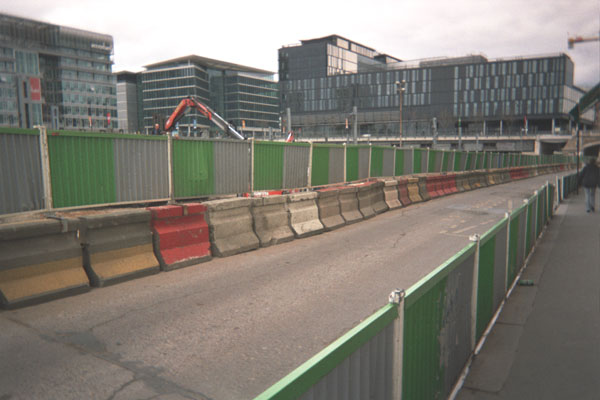
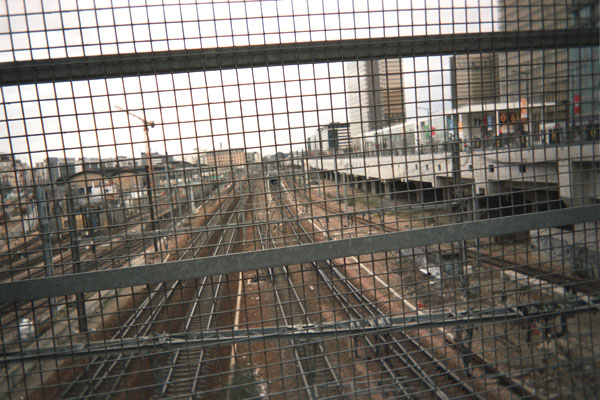
However, in Paris one is never far from culture
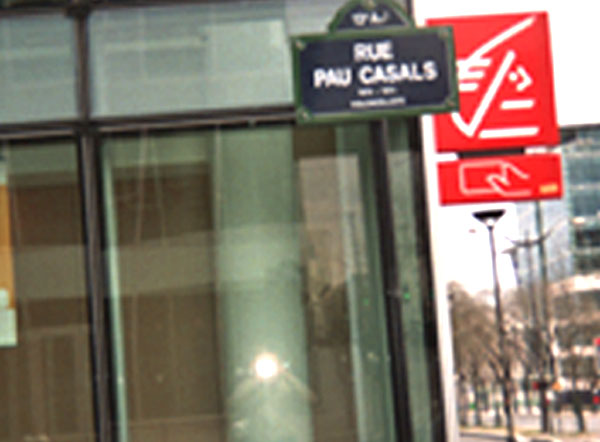
A receptionist sat behind a counter in a darkened lobby of a building housing the offices of the Presses de la Cite on its upper floors. In her twenties and not particularly friendly, she knew nothing about the book trade and didn't much feel like talking. Her job description only included receiving manuscripts and other packages and catapulting them to the Presses de la Cité offices. Her stare indicated that as far as she was concerned I didn't look like a writer , justifying a generally sardonic manner towards me, which was only appropriate.
In the course of our conversation I realized that it was in my interest to compose a letter outlining the contents of the novel together with an explanation of why, although it's written in English, I think it ought to be published in France.
Back at the CNRS by 7:30 PM . The building is closed to the public after 5, and a chain inside the lobby across the transparent glass entrance allows only a narrow access on the far left of the glass doorway, where one will be scrutinized by a security guard. A diminutive individual crumpled into a swivel chair, he was dressed in a drab blue suit, his hair crewcut like a marine's, with a few days growth of beard . He wasn't hostile, merely the kind of person that doesn't like being disturbed and enjoys making difficulties. I asked him if he would use his telephone to call up to Leila and Pierre and let them know that I was downstairs in the lobby waiting for them. The man made a few attempts at calling, then turned to me and said: "the phone isn't working" , indicating, no doubt, that this was the end of the story and I should go away ! I remarked that this sounded like something out of Kafka. He smirked pleasantly - he'd read Kafka! Fortunately Leila and Pierre themselves came down 10 minutes later.
They took me to their car and we drove off to a Moroccan restaurant in the neighborhood of the Place de la Bastille . Convinced that I was destined to return home very lean and hungry once the value of the dollar dropped to nothing, they encouraged me to stuff myself up to the limit of my (ontogenetically recapitulated ) gills. The 3 of us shouted facts. data, theorems and figures at one another in English at bullet-speed, the normal behavior of mathematicians in public situations, upsetting people at all the neighboring tables who were unable to understand the sacrifices that must be made for the advancement of science. Pierre and Leila bought several of my Ferment Press books, dropped about 50 Euros on me, and stood guarantee that, worse comes to worst, I would not at any time during this trip find myself sleeping under the bridges of the Seine.
Day 3 , Thursday, March 10 :
Over the course of 24 hours , starting with the morning rush hour, the transportation strike increased in intensity. Waiting on the platform of Porte d'Orleans at the Chatelet station I was approached by two families of Japanese tourists, husbands, their wives and 5 children. The spokesman for the group , a tall , slender man in his 40' s, spoke a good English. He asked me for directions to the Place de l'Odeon . After I told him how to get there he explained that the group needed to take a train very early the next morning to the Aeroport Charles de Gaulle, to catch a flight to London at 7 :45 AM. Could they use their ordinary Metro tickets to get there? I explained to him that the trains going to the airport are part of a different system; also that the tickets to the airport will cost about $10 apiece . They needed to allow an hour on the train from the Gare du Nord, and an hour at the airport before the scheduled flight time they were on the train.
He explained that they'd tried to reserve a taxi for the next morning but had gotten nowhere. I reassured them that they would not have been much more successful had they been French. Together we figured out that the whole contingent needed to be out of the hotel and on their way to the Gare du Nord by 5 AM the next morning. Their travel itinerary included 2 days in London and a return trip back to France to catch a plane to the United States. This was their first visit to Europe. I left them at the Place St. Michel where I transferred to the RER B going to the Jardins du Luxembourg. My destination was the Institut Poincaré , a world famous conference center and school for theoretical and mathematical, located in the charming "science city" bounded by the rue Gay-Lussac, rue d'Ulm and rue l'Homond. Here one finds the Curie Institute, the Pasteur Institute, the Poincaré Institute , the École Normale Superièure, the Oceanographic Institute and so on . Aging scholars with white beards and ponderous tred roam about the streets; obviously I fit in.
For the early mornings the Poincaré Institute served as yet another base of operations during this visit to Paris: the vile coffee one finds all over Paris is only 55 centimes per demitasse here . The pastries are actually quite good but also cheap. It has a public telephone conveniently set off in an alcove, an excellent mathematics library covering the whole second floor. Not the least of its attractions are the science conferences taking place virtually every weekday and most weekends from 9 AM until 6 PM and beyond. I attended one of them the next day which will be covered in the appropriate place.
The transportation strike obliged me to walk all the way from the station Luxembourg to the Centre Pompidou, that is to say the length of the Boulevard St. Michel as far the Place St. Michel , then across the river and due north for several blocks. In the Place St. Michel I caught up again with the Japanese families! They were totally lost and very unhappy. Because of the strike they'd been unable to visit any of the municipal attractions they'd come to see. I sympathized, of course . Since I've already visited most of these places over the years, my interest in Paris is more focused on its people; for me the transit strike was a marvelous opportunity for observing them.
As it turned out, the Centre Pompidou was also closed due to the strike and I continued on to the Musée des Arts et Métiers, (which was open) , to learn something about the "physique des femmes" (!! )_ This museum was established in the 18th century during the French Revolution by the one of its few truly enlightened spirits, the abbot Henri Grégoire. By getting approval for his museum inside a monastery secularized by the revolutionary government, he was able to save its architecture. For those familiar with the Franklin Institute in Philadelphia, one might describe the Musé des Arts et Métiers as a more grandiose version of same.( Indeed, it is more than likely that he and Franklin clinked wine-glasses , if not glass harmonicas, on more than one occasion!)
The inventions , most of them in temperature- regulated glass cases and beautifully maintained, date back to the end of the 17th century. Most of them are by French inventors. Also, beginning with the 19th century most of them were graduates of the Conservatoire des Arts et Metiers, a French M.I.T. situated down the street a ways from the Museum. France boasts several famous engineering schools , including the Polytechnique and Les Grands Ecoles . Hell may well be a place with French engineers and English cooks, German politicians and American lovers, but the truth is that French engineering has an excellent reputation around the world: many French engineers go abroad owing to limited opportunities in their own country. To take one example, the charming Montreal Métro was built by French engineers unable to realize their ideas in France.
One wanders through a series of rooms holding pumps, mills, turbines, generators, lathes, machine tools, voltaic piles, assembly lines, early automobiles, extravagant monumental clocks, a complete reconstruction of an early locomotive, etc.The jewel of the museum is its Foucault Pendulum. This hangs on a wire about 50 feet long from the vault under the spire of the old monastery. The antechamber that contains it is illuminated by the sunlight pouring through panels of beautiful stain glass depicting the traditional superstitions. I happened to arrive there slightly before 5, at which time the staff person in charge of the pendulum redirects its massive weight to the default location and releases again . His exposition was first-rate. Leon Foucault is yet another one of those heros of 19th century science who fell victim to the scientists, a man of extraordinary talents, indeed genius, who was blocked every step of the way since he had hadn't been educated in the "right places" (Plus ça change, plus c'est la même chose ! ) . As some of the spectators understood English but no French, I was drafted to translate his lecture for their benefit. He also turned to me to confirm some of the physics, which is difficult and which I understood only imperfectly at the time. I thought of asking for a refund on my museum admission. The problem here was that I'd already gotten in for free by claiming to be a journalist !
The mathematics involved in understanding how the Foucault Pendulum works contains some subtleties, and a good part of my mental energy over the rest of my day was consumed by trying to thinking them through until I'd convinced myself that understood them.
Indeed it would be another two months and consultation with a textbook before the calculations of the trajectory of the pendulum became crystal clear to me .
As things stand now, I should be able to apply to the Musée des Arts et Metiers for the job of English-language tour guide to the Foucault Pendulum !
The subway cars were still crammed like cans of sardines ( not tuna fish which always seem to be mostly empty) , so I walked the rest of the way to the hotel. A good, cheap dinner was uncovered at a short order restaurant known as a traiteur , generally a Chinese or Japanese take-out restaurant with individual items like saffron rice, bean sprouts, beef or chicken dishes, etc. The delicious Japanese tea served at this restaurant cleared my system of the remnants of the dregs of Parisian coffee.
Day 4, Friday March 11 :
A "standing up" coffee was taken at the local tabac. This costs one Euro ($1.33) less than a "sitting down" coffee, a tradition which may well date back to Vercingetorix. The ambiance was quite lively. The woman who runs the tabac has obviously taken a shine to me which is upsetting since she's rather attractive. After breakfast I left for the Barclay Bank on the rue Daumesnil, directly accessible from Place de la Republique. I'm using this bank to withdraw currency because its the only one that doesn't charge the $5 international transaction fee.
When I got there I learned that this branch is just an administrative center, the main bank being on the Champs-Elyséés.Using the ATM stall out on the street I was able to withdraw 300 Euros. Unfortunately there was no way of telling how many Euros remain in my account (which was $1000 at the time of the withdrawal) and the man inside the bank behind the desk, a very pleasant individual, didn't know the exchange rate. Consequently I don't know how much more I'll be able to withdraw. Assuming a ratio Euros:dollars = 3:4 between Euros, I've still got 450 Euros left.
From station Daumesnil there is a direct connection to station Chevaleret. I went there next to compose and send off the report on Day 1. At the entrance to CNRS there is a sign , on which a picture of a dog (quite amateur given the reputation of France for the arts), is slashed by a diagonal bar: "No Dogs Allowed" one supposes. I really ought to inform the building managers that a PhD in mathematics was awarded to a dog at Hope University last month. They really ought to take down the sign!
At around 1:30 I went back to the Institut Henri Poincaré to attend a first-rate conference on Mathematics Education in America, Germany and Italy from 1870 to 1930 . Despite the esoteric character of the subject matter, the talks were of absorbing interest and I stayed there until 6:30. The extended period of commentary and questions was still in progress when I left.
Institute Poincaré conference on mathematics education.
Saturday, Day 5 , March 12, 2005
Jet lag no doubt accounts for my waking up in the first week of my stay in Paris 2 hours later than my normal time. On this morning I left the hotel at 9, having decided to check out the Sarah Bernhardt café on the Place du Chatelet. It's located to the left of the municipally supported Theatre de la Ville, the former site of Bernhardt's own theater. Although in my opinion there's never been any question about the winner of the fabled Bernhardt/Duse competition, Sarah Bernhardt was a formidable theatrical phenomenon in her own right at the turn of the century. That she was unapologetically Jewish and successfully portrayed the lead role in "Hamlet" in late middle age and with an amputated leg also says much in her favor.
I'd gone there as much for the interior, vintage 19th century Art Deco, as for its historical associations. I've long ago ceased being one of those dumb though acculturated American tourists who go to the revolting Café des Deux Magots looking for J.P. Sartre, or the cafés and restaurants around the Odeon hoping to catch a glimpse of James Joyce or Gertrude Stein. Why not go to Camden, New Jersey on the lookout for Walt Whitman? But actors and personnel from the numerous neighboring theaters do come into the Sarah Bernhardt once in awhile, besides which it's one of the settings for "The Eiffel Tower Gang": Inspector Migraine goes there to requisition a lemonade to help him decipher a message written in invisible ink on the sides of the trottoir roulant !
From the counter I counted no more than 6 customers sitting at tables. If I wanted to meet interesting people I should have come in the evening. The café au lait cost a pretty centime, about my estimate. I appreciated the fact that the management did not mind my taking several photographs, (none of which came out)
A derelict entered the café from a side door and began making the rounds of the tables, asking for cigarettes. The counterman, a brawny garrulous sort, a product of farm life and the epitome of animal health and spirits, took his arm, walked him to the window, pointed in the direction of a tabac, and ordered him outdoors. Leaving the cafe 20 minutes later I found the derelict standing on the pavement by the door from which he'd been evicted. His face was covered with black stubble and he was emaciated and obviously drunk.Although his left hand was extended for money, his right held a brand-new unopened bottle of Merlot! ''Vous avez déjà votre vin. Ça suffit!" I cried. His curses followed me down the street.
The block across the street from the Sarah Bernhardt holds a public park, seperated (sic!) from a grey pavement by a surrounding metal fence. Lying in sleeping bags on the southeastern corner of the pavement were two homeless women. A mound of white plastic garbage bags held their personal effects. The rain that morning had soaked their possessions and bedding.

Clearly their situation was different from that of the alcoholic I'd just encountered, and I walked over to them with my right fist closed around a stack of coins totaling about 3 dollars. One of the women was African, the other European. The African woman saw me coming and scolded me: Non, Monsieur. Merci. On n'a pas besoin! : We don't need it!
I was heading for the Centre Pompidou in the Place Beaubourg.
My guiding principle for this trip has been to take in as many free things as possible at the beginning. What is left over by the end of the month can be squandered in one final blast.
Thus I was able to tell myself that I'd already visited the art galleries in a previous trip in 2001, and didn't need to pay admission for the film festival at the basement level because I hadn't come to France to sit in a room watching movies.
This pool fills up the space between the Centre Pompidou and IRCAM
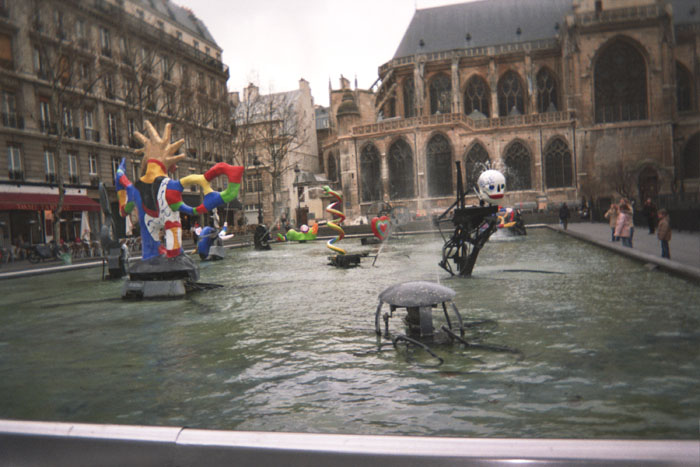 In the lobby of the Centre Pompidou there was a poster, indicating that an "Exhibition of Design" was being presented on the mezzanine; this forms a rim which is visible from the ground floor lobby . I ascended the staircase to visit it, only to discover that the title was a deception to get the public to inspect the wares of a Printemps department store display advertising cheaply fashioned objects like cups, forks, bracelets, bibelots. Promoted as "art", I wouldn't have bought these things for any amount of money. Back once again on the ground floor, I followed signs indicating the way to the library. These led me all the way to the back wall, where a final sign indicated that one had to retrace one's steps and walk all the way around the outside of the building to come back to the same place on the other side of the floor-to-ceiling glass window! Since a chain-link fence barricades the cobblestoned parvis , or esplanade, in front of the building from the side streets, the walk was something of an inconvenience. In addition to which the rain had started up again. As I had frequent occasion to remind myself in this return to France, he who does not want to walk does not want to travel.
In the lobby of the Centre Pompidou there was a poster, indicating that an "Exhibition of Design" was being presented on the mezzanine; this forms a rim which is visible from the ground floor lobby . I ascended the staircase to visit it, only to discover that the title was a deception to get the public to inspect the wares of a Printemps department store display advertising cheaply fashioned objects like cups, forks, bracelets, bibelots. Promoted as "art", I wouldn't have bought these things for any amount of money. Back once again on the ground floor, I followed signs indicating the way to the library. These led me all the way to the back wall, where a final sign indicated that one had to retrace one's steps and walk all the way around the outside of the building to come back to the same place on the other side of the floor-to-ceiling glass window! Since a chain-link fence barricades the cobblestoned parvis , or esplanade, in front of the building from the side streets, the walk was something of an inconvenience. In addition to which the rain had started up again. As I had frequent occasion to remind myself in this return to France, he who does not want to walk does not want to travel.
The southern walkway, connecting front and back of the Pompidou Center
The Centre Pompidou library, or mediathèque is deservedly popular. When I finally got there I realized that the line of people waiting at he entrance to get in stretched over half a city block. Through observing its forward progress with my watch I calculated that it would probably take half an hour to be admitted. Its resources are well worth the inconvenience! But at that moment lunch was more important. Cheese, paté, bread, apricot juice and sardines were picked up at the grocery store ( "ED" ) across the street and carried back into the Centre Pompidou. An open cafeteria is situated on the mezzanine. A vacant table was available at which I seated myself and set to work opening up one of the cans of sardines.
The tabs on the upper face of the can were the familiar kind that break when you try to use them. Sitting together at the table next to mine were a little cute girl of about 6, and her mother. The child went into gales of laughter at my distress; I had to concur that it was indeed a classical comic routine. Then a young man got up from a nearby table and walked over to give me one of the cafeteria's long stainless steel spoons. It worked like a charm; the tin cover was soft and yielded readily to the edge of the spoon.
I'd just started to eat when a huffy waiter appeared from the left and confronted me. He came right to the point, wagging an admonitory finger : No pique-nique ici ! . Not that he wasn't unfriendly; indeed, the directors of the Centre Pompidou had given some thought to working out solutions for personal dilemmae such as mine. I would be allowed to bring my opened sardine can into the dining room of the art gallery on the upper floors if I paid the $15 admission.
I wasn't going to pay $15 for the right to eat. The Centre Pompidou is financed with municipal taxes and it doesn't seem right to me that the Printemps department store and this café should be able to operate private concessions with public money, while members of the general public are denied the right to have lunch. I collected my bags, grasped the opened sardine can in the palm of my right hand and walked it around the mezzanine, down the escalator and through the crowds of people walking about the large lobby. The experience was stimulating, while supplying me with me lots of ''food for thought '' concerning the philosophical connections of art and food . I also took the stainless steel spoon.
I hastily finished up the rest of my improvised lunch seated on a wet park bench. Even the rains proved inadequate to the dampening of my spirits. Now I was headed in the direction of the studios of IRCAM , the center for experimental research in music founded by Pierre Boulez, adjacent to the Centre Pompidou. More conservative, yet more inspirational that those of the Center, the entrance doors at IRCAM are strappingly modern, slick Bauhaus line, circle and rectangle constructions of glass and metal. In the foyer to the left of the entrance foyer a poster standing in a glass case on the wall announced that a day-long conference was slated for the following day, Sunday, March 13. The topic would be developments in new technologies, hardware and software, for use in musical composition. As a highly talented beginner composer since 1968, it was right up my alley.
IRCAM, old entrance
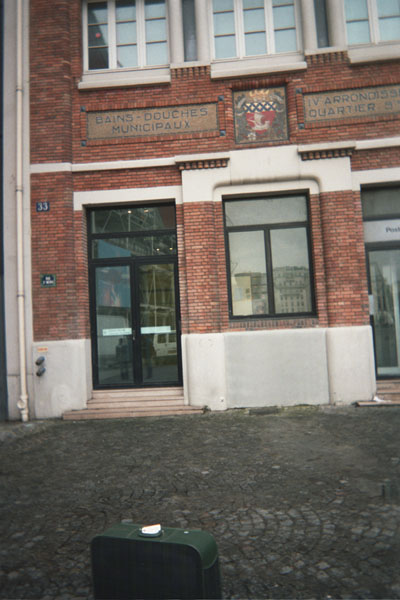
IRCAM, new entrance
Returning to the Hotel Picard at 2, I placed the groceries into a cupboard and rested up for the next hour. Around 2:30 a phone call came through to me from Switzerland! The caller was a Dr. Schenk of Zurich, an enthusiastic reader of Ferment Magazine. He'd got my phone number at the Hotel Picard from the information I'd posted on its homepage. Schenk He wanted to talk to me about :
(1) Recent developments in the research community on the Kennedy assassination,
(2) Information about the Shakespeare & Company bookstore, which he'd last visited in 1953, and,
(3) The whereabouts and condition of Alexandre Grothendieck!
Dr. Schenk speaks an excellent university-acquired English of distinctive Oxonian bouquet.(One of the two dialects of British English, the other being Cockney.y) It was a pleasure talking with him.
Shakespeare and Company was in fact my next stop. I found George Whitman, the 91 year old proprietor, sitting in the rare book annex with his daughter, Sylvia ( named after Sylvia Beach). As i walked into the room, George looked up and said: " Ah yes, Roy Lisker. You need a bed for the night?'' Our friendship goes back 40 years. I arranged to stay for several days starting the following Thursday.
Shakespeare & Company. Sylvia Whitman is the young lady to the right in the pair at the center
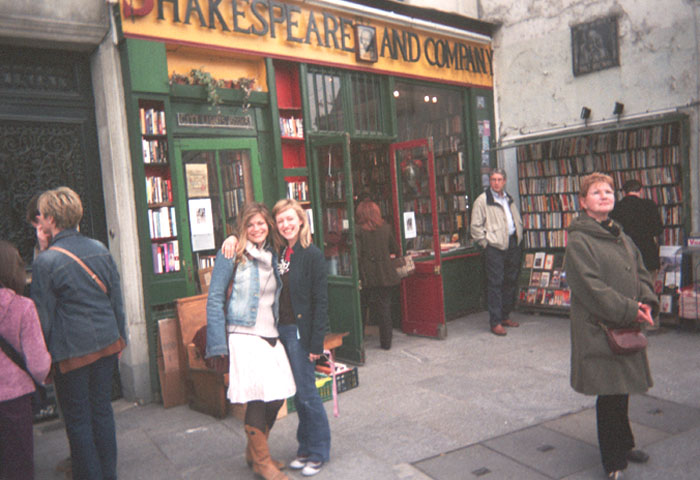
One of the great things about staying at Shakespeare and Company is that one is constantly being reminded that one is "on the road". Conditions are grim, but the company is marvelous and one is surrounded by books, (that is to say, the works of my competitors!! ) . Normally I can't take more than 5 days of living there. However it is the place in Paris, indeed in Europe, for meeting and communicating with writers from all over the world. Its also filled with young vagabonds, dubbed "tumbleweeds" by George, that I enjoy being with and want to help.
For dinner I took the RER B train up to the International Center at the Cité Universitaire. Just a few words. The gardens, grounds and architecture are very charming, the kind that invariably conjure up stray fragments of Mozart. One invariably lingers outside for awhile before entering. It's one of those magnificent "hotels", aristocratic 18th century mansions taken over by the goverment and converted into museums and functioning public buildings. To reach the cafeteria one crosses the tiled and polished floor at the back. I'd come early; the tables were preprared but all the rooms were deserted. A North Africa kitchen worker came out to ask me what I wanted. A curious conversation developed. After informing me that dinner would not be ready for another half hour, he asked:
"Vous etes de quelle nationalité? "
"Americaine."
"You're an American?" He paused : "Well, then you must go to Iraq." His tone was droll, as if to imply that he didn't give a damn one way or another.
" I wouldn't go to Iraq to shoot people. I would only go to help them get better."
"Ah? So you're a doctor? A medical student." Why not play along?
"Yes."
He waved me off on a friendly fashion. There is a cafe adjacent to the cafeteria where I sat over a beer and waited out the half hour. When the cafeteria open I discovered, as expected, that the meal was very cheap, no more than 3 Euros, and also very bad. I recall no other meal in recent memory whose elements (sausage, macaroni, peas and carrots and a slice of lox), had no taste. None whatsoever! I might as well have eaten the strings of an old mop.
Despite this serious drawback to the cuisine I ended up taking 3 meals at the Cité Universitaire on this trip to Paris . My principal reason for going there was not to eat cheaply , but to meet with and talk to students. While bolting down these distasteful substances ( substance abuse? ) I engaged in discussions about economics, science and politics with 2 Tunisians, an Algerian, an elderly man from Somalia, a student from Tchad, and a graduate student in economics from Senegal. It was worth it. The remnants could later be washed down with a half-liter of draft beer in the adjacent café.
Sunday, March 23,2005:Report on the conference at IRCAM
